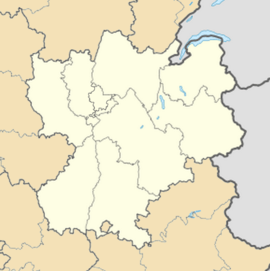Les Ollières-sur-Eyrieux
| Les Ollières-sur-Eyrieux | |
|---|---|
|
A view towards Les Ollières-sur-Eyrieux | |
 Les Ollières-sur-Eyrieux | |
|
Location within Rhône-Alpes region  Les Ollières-sur-Eyrieux | |
| Coordinates: 44°48′23″N 4°37′19″E / 44.8064°N 4.6219°ECoordinates: 44°48′23″N 4°37′19″E / 44.8064°N 4.6219°E | |
| Country | France |
| Region | Rhône-Alpes |
| Department | Ardèche |
| Arrondissement | Privas |
| Canton | Privas |
| Intercommunality | Eyrieux aux Serres |
| Government | |
| • Mayor (2008–2014) | Gilbert Valette |
| Area1 | 7.58 km2 (2.93 sq mi) |
| Population (2008)2 | 921 |
| • Density | 120/km2 (310/sq mi) |
| INSEE/Postal code | 07167 / 07360 |
| Elevation | 157–400 m (515–1,312 ft) |
|
1 French Land Register data, which excludes lakes, ponds, glaciers > 1 km² (0.386 sq mi or 247 acres) and river estuaries. 2 Population without double counting: residents of multiple communes (e.g., students and military personnel) only counted once. | |
Les Ollières-sur-Eyrieux is a commune in the Ardèche department in southern France.
The nearest towns are Privas and Saint-Sauveur-de-Montagut.
History
The first records of a settlement can be dated back to the 12th century. Situated on the banks of the Eyrieux river (a tributary to the Rhône river), Les Ollières (as it is often shortened to by the local people) became a central location for the treatment and processing of silk in the early 18th century. The silk (and later different textiles) industry was to feature heavily in the surrounding area.
21st century
The village has now become a tourist location, attracting many Dutch, German, Swiss and English tourists to its many camp sites during the summer months. Although some tourists have started to renovate old cottages and set up permanent or holiday homes in the area.
Population
| Historical population | ||
|---|---|---|
| Year | Pop. | ±% |
| 1793 | 860 | — |
| 1800 | 921 | +7.1% |
| 1806 | 905 | −1.7% |
| 1821 | 1,024 | +13.1% |
| 1831 | 1,138 | +11.1% |
| 1836 | 1,226 | +7.7% |
| 1841 | 1,205 | −1.7% |
| 1846 | 1,348 | +11.9% |
| 1851 | 1,467 | +8.8% |
| 1856 | 1,368 | −6.7% |
| 1861 | 1,405 | +2.7% |
| 1866 | 1,352 | −3.8% |
| 1872 | 1,431 | +5.8% |
| 1876 | 1,452 | +1.5% |
| 1881 | 1,387 | −4.5% |
| 1886 | 1,470 | +6.0% |
| 1891 | 2,309 | +57.1% |
| 1896 | 1,872 | −18.9% |
| 1901 | 1,920 | +2.6% |
| 1906 | 1,968 | +2.5% |
| 1911 | 1,272 | −35.4% |
| 1921 | 1,154 | −9.3% |
| 1926 | 1,194 | +3.5% |
| 1931 | 1,200 | +0.5% |
| 1936 | 1,110 | −7.5% |
| 1946 | 1,017 | −8.4% |
| 1954 | 993 | −2.4% |
| 1962 | 1,015 | +2.2% |
| 1968 | 960 | −5.4% |
| 1975 | 788 | −17.9% |
| 1982 | 793 | +0.6% |
| 1990 | 769 | −3.0% |
| 1999 | 797 | +3.6% |
| 2008 | 921 | +15.6% |
Transportation
For the people of Les Ollières a daily bus service runs to Valence and Privas.
See also
References
| Wikimedia Commons has media related to Les Ollières-sur-Eyrieux. |
